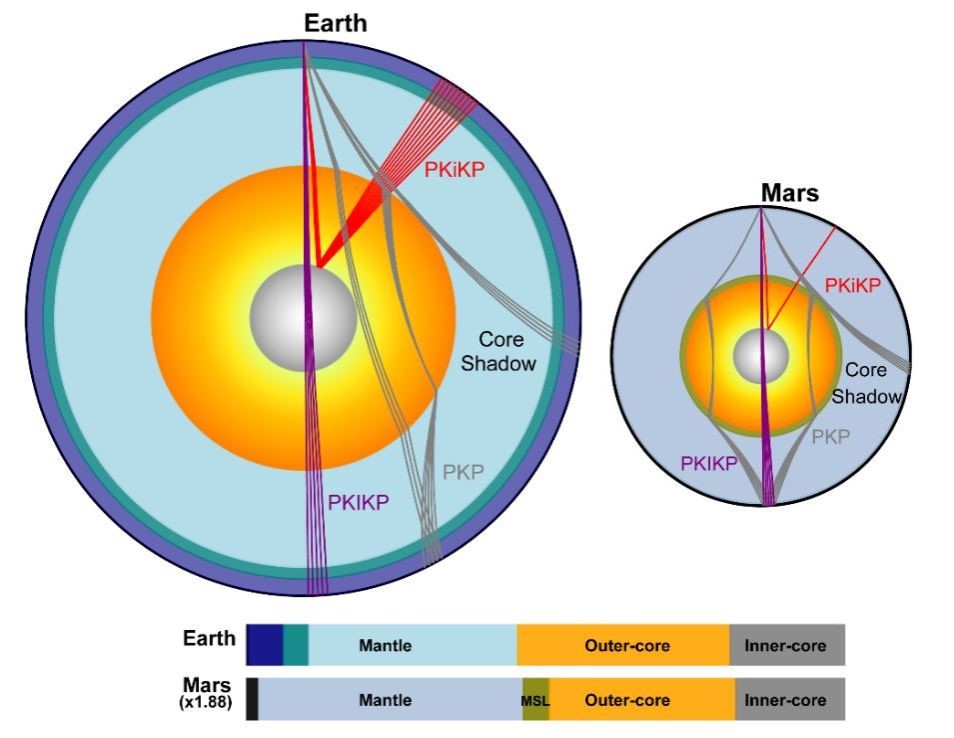Chinese Scientists and International Collaborator Make Breakthrough in Understanding Mars’ Core Structure and Composition

Figure. Comparison between the interior structures of Earth and Mars.
Professor Sun Daoyuan, Professor Mao Zhu, and their research team at the University of Science and Technology of China (USTC), supported by the National Natural Science Foundation of China through the special project “Scientific Research on the Moon and Deep Space Exploration (I)” (Grant No. 42241117) and the project “Fine Structure and Temporal Mechanisms of the Earth’s Core” (Grant No. 42394113) and in collaboration with international partner, have made significant progress in planetary science. Their findings, titled “Seismic Detection of a 600-km Solid Inner Core in Mars,” were published in Nature on September 3, 2025. Paper link: https://www.nature.com/articles/s41586-025-09361-9.
As the most Earth-like terrestrial planet in the solar system, Mars has long been a key target in the study of planetary interior structure and evolution, as well as a focus for deep space exploration missions. However, probing Mars’ internal structure has proven extremely challenging. It was not until 2018 that NASA’s InSight lander provided the first seismic data from Mars. Despite recording over a thousand marsquakes to date, the weak signal amplitudes and high noise levels have significantly hindered efforts to explore the planet’s deep interior.
The research team employed an innovative seismic array analysis method to the marsquake data collected by InSight. By analyzing 23 high signal-to-noise events, they successfully extracted critical seismic phases that traverse Mars’ core (Figure). Notably, the team observed that the arrival times of the PKKP phase were 50 to 200 seconds earlier than predictions made by velocity models assuming a pure liquid core. This discrepancy suggests that Mars’ core is layered, consisting of an outer liquid core and a deeper solid inner core with a higher seismic velocity.
Further analysis identified the PKiKP phase — a seismic phase considered a definitive indicator of a solid inner core (Figure). This observation provides the first direct seismic evidence of a solid inner core within Mars. By incorporating additional core-sensitive phases, the team estimated the radius of Mars’ solid inner core to be approximately 600 kilometers, about one-fifth of the planet's radius. When compared to Earth’s size, the core-to-planet ratio closely resembles that of Earth.
The study also revealed a roughly 30% P-wave velocity jump and about a 7% density difference across the boundary between the outer and inner core. Based on these findings, the team analyzed the potential composition of Mars’ inner core, concluding that it likely contains not only iron and nickel but also 12–16% sulfur, 6.7–9.0% oxygen, and up to 3.8% carbon. This light-element-rich structure of the core offers crucial insights into the evolution of Mars’ magnetic field — from its active past to its current dormant state — and provides a critical reference point for understanding the divergent internal evolutions of Earth and other terrestrial planets.
This research marks the first confirmation of a solid inner core within an extraterrestrial planet, demonstrating that Mars possesses a core-mantle differentiation structure remarkably similar to Earth’s. It represents a significant contribution to the study of planetary interiors and showcases China’s growing innovation and international influence in the interdisciplinary field of planetary science and geophysics.
Contact Us

National Natural Science Foundation of China
Add: 83 Shuangqing Rd., Haidian District, Beijing, China
Postcode: 100085
Tel: 86-10-62327001
Fax: 86-10-62327004
E-mail: bic@nsfc.gov.cn
